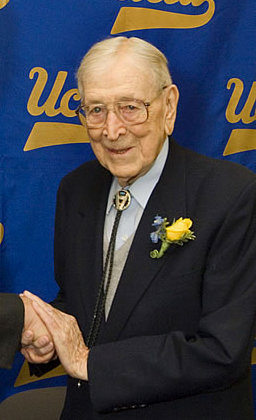
- Image via Wikipedia
A lot of people believe that you have to be harsh and loud to be an effective disciplinarian. The great example of UCLA coach John Wooden however tells us that discipline is much more than volume. It has everything to do with doing the right things in the right way on a routine basis in order to create an identity that will guide us through difficult times.
As an analogy, military discipline is what holds good units together in times of maximum stress and combat. The discipline anchors us into routine ritual behaviors which have a survival payoff in combat.
In sports, the discipline to do the right thing in the right way every day builds the habits that we need to win on the practice field so that they’ll be available to us automatically in the game.
As an example, if we are in the habit of wearing her uniform properly, then the equipment will not fail us at the crucial moment. If we follow a discipline of warm-up and stretching before every practice, and doing it in again will come as second nature and our injury rate will be much lower.
If we are in the habit of performing our little tasks to a high standard even when no one else is looking, and that discipline will carry over into how we performed on the big tasks.
How do we help young athletes achieve a state of discipline? I think it’s necessary to begin realistically with a few small things that we can build on as we grow our discipline muscles. “If the attitude of the team in your group huddle. When the coaches speaking everyone should be giving him their full attention. As a coach, if you see your players not paying attention or talking with when you’re talking, and how you handle that moment will go a long way towards establishing the climate of discipline.
When your athletes are talking out of turn, they have to know already that this is not acceptable behavior. That means you had to have told them in the very first practice what the standards are for the team when you’re talking. There to give you the respect full undivided attention and be ready to taking your words and apply them on the practice field. Inevitably, some kids will be talking when you’re talking.
Be firm but fair and insist upon their attention before you proceed. You can even ask them if they have anything else that like to contribute to the group before you proceed with your information. They will quickly get the message that it’s not their turn to talk. If their behavior persists, then you may have to take them aside and explain to them why their behavior is unacceptable and what the standards of the team are.
Make sure you framed this as a choice that they will make in order to be a member of the team. You cannot impose discipline on others, you can only encourage it by the force of your personal example.
As in all things, teaching by example is the best way to instill the lessons of disciplining your young athletes. Pay attention carefully when they’re talking, and take them seriously. Show them that you care about the little things in the way that you use language and care for equipment. Insist on doing things the right way for the right reasons and reinforce those lessons verbally with them so that they see how discipline touches everything on our team.
John Wooden started his UCLA season with a demonstration of how to properly trim toenails and fingernails. He was making the point that at UCLA they did everything properly, keep that in mind as you prepare for your next practice. Good coaching!
Related articles by Zemanta
- You Can Create The Self Discipline Habit, Self Discipline Is A Learned Behavior (realgoalgetter.com)
- Analysis: St. John’s Hires Lavin as Coach (nytimes.com)
- St. John’s Names Steve Lavin Head Coach: Clumsy Process Leads To Clumsy Hiring (bleacherreport.com)
- Worker disciplined over wrench fall (cbc.ca)
- Baseball and brotherly love, the tough Romero way (thestar.com)
- NCAA Expansion: Open Letter to The NCAA, Please Don’t Expand The Tournament (bleacherreport.com)
- Why Ben Roethlisberger’s Suspension Is a Step Down a Slippery Slope (bleacherreport.com)
- Coach Goes to Denver on a Lacrosse Crusade (nytimes.com)
- Leroy Hill of Seattle Seahawks still at home until NFL discipline (sports.espn.go.com)
- How to Focus on Buyer Goals to Grow Top Line Revenue (thecustomercollective.com)
- A reflection on Hunt’s “Leadership: A new synthesis” (1996) (kansasreflections.wordpress.com)
- A reflection on entreprenurial spirit and stability operations, and engagement areas in nation-building (kansasreflections.wordpress.com)
- Youth soccer coaching: picking a good formation for U11 teams (kansasreflections.wordpress.com)
- appreciative intelligence improves youth soccer coaching (kansasreflections.wordpress.com)
- Excellent summary of forward thinking Army leaders (kansasreflections.wordpress.com)
- Learning from the process consultant (kansasreflections.wordpress.com)
- Appreciate Coaching: The Power of Positive Self Talk (kansasreflections.wordpress.com)
- A reflection on self-directed education and doctoral programs (kansasreflections.wordpress.com)
- Youth soccer coaching: preparing your halftime speech (kansasreflections.wordpress.com)

![Reblog this post [with Zemanta]](http://img.zemanta.com/reblog_e.png?x-id=1c47ed9b-714a-4a4d-a719-78d901c8f6d1)